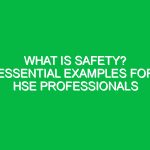Greetings and Introduction
Hello team! Thank you for gathering here today for our Toolbox Talk. Today, we’ll focus on a vital topic that affects our daily operations: Dealing with Hazards within the Health, Safety, and Environment (HSE) domain. Understanding how to manage Hazards is not just important for compliance; it’s essential for keeping ourselves and our colleagues safe while we work. Let’s dive into some essential tips and practices that will help us effectively deal with hazards in our workplace.
Understanding the Importance of Dealing with Hazards
First, let’s consider why Dealing with Hazards is critical in our work environment. Every job comes with its own set of risks, whether they stem from machinery, chemicals, or simply the layout of our workspace. By addressing these hazards proactively, we can significantly reduce the likelihood of accidents, injuries, and even fatalities. This not only protects our physical well-being but also promotes a culture of Safety that Benefits everyone.
Key Aspects of Hazard Management
Effective hazard management involves several key aspects:
- Identification: Recognizing potential hazards before they cause harm.
- Assessment: Evaluating the risks associated with identified hazards.
- Control: Implementing measures to eliminate or minimize risks.
- Review: Regularly revisiting hazard management practices to ensure effectiveness.
Let’s break these down further.
1. Identification of Hazards
Identifying hazards is the first step in Dealing with Hazards. Encourage everyone to stay vigilant and look out for anything that could pose a risk. This could be something as simple as a wet floor, exposed wiring, or improperly stored materials. Utilize daily checklists and encourage open communication among team members to enhance hazard identification.
2. Risk Assessment
Once hazards are identified, the next step is to assess the risks they present. This involves asking questions such as:
- What is the likelihood of an incident occurring?
- What would be the potential consequences of that incident?
- Who could be affected?
Understanding the level of risk helps prioritize which hazards need immediate attention and which can be managed over time.
3. Control Measures
After assessing risks, it’s time to implement Control Measures. These can include:
- Engineering controls (e.g., installing guards on machines)
- Administrative controls (e.g., rotating job duties to minimize exposure)
- Personal protective equipment (PPE) such as gloves, helmets, and goggles
Each control measure should be tailored to the specific hazards present in your work environment.
4. Review and Continuous Improvement
Finally, regular reviews of our hazard management practices are essential. Encourage feedback from team members and look for ways to improve existing measures. This creates a dynamic Safety culture where everyone feels invested in maintaining a safe workplace.
Real-Life Examples of Hazard Management
Let’s consider a few real-life scenarios that demonstrate the importance of Dealing with Hazards effectively:
- Scenario 1: A construction site where workers noticed a loose scaffold. By reporting this hazard immediately, a potential fall was prevented, demonstrating the importance of identification and quick action.
- Scenario 2: In a warehouse, a team regularly conducted risk assessments and discovered that certain lifting techniques were causing repeated injuries. By implementing Training on proper lifting techniques and providing mechanical aids, they reduced injury rates significantly.
- Scenario 3: During a routine review, a manufacturing plant identified that outdated machinery posed safety risks. They replaced it with newer, safer models, illustrating the importance of continuous improvement in hazard management.
Actionable Tips for Conducting Effective Toolbox Talks
Now that we’ve established the importance of hazard management, let’s discuss how to conduct effective toolbox talks focused on Dealing with Hazards.
1. Prepare Thoroughly
Preparation is key to a successful Toolbox Talk. Gather relevant materials, such as safety data sheets and incident reports, to provide context. Understand the specific hazards that your team might face and tailor the discussion to those points.
2. Engage the Team
Ensure the talk is interactive. Encourage questions, share anecdotes, and invite team members to share their experiences with hazards. This promotes a culture of safety and teamwork.
3. Keep it Relevant
Focus on hazards that are specific to the work being done that day or week. If you’re preparing for a project that involves heavy lifting, discuss techniques for safe lifting and the importance of using PPE.
4. Use Visual Aids
Visual aids can enhance understanding. Use diagrams, charts, and even real-life demonstrations to illustrate points. For example, showing the correct way to wear safety equipment can reinforce its importance.
5. Provide Clear Instructions
Make sure to outline clear safety protocols and Procedures. Provide step-by-step instructions on how to deal with specific hazards. For instance, if discussing chemical spills, outline the exact steps that need to be taken in case of an incident.
Open Discussion and Engagement
At the end of the talk, open the floor for discussion. Ask open-ended questions to encourage participation:
- What hazards have you encountered recently?
- How do you think we can improve our hazard management practices?
- What additional training do you feel is necessary to enhance our safety culture?
These discussions can provide valuable insights and foster a team-oriented approach to safety.
Regulations and Standards
It’s also essential to be aware of relevant Regulations and standards that guide our safety practices. Familiarize yourself with OSHA regulations, ISO standards, and company safety policies. Compliance not only ensures legal protection but also enhances our credibility as a responsible organization.
Understanding these regulations helps us meet our legal obligations and reinforces our commitment to maintaining a safe working environment.
Conclusion and Commitment to Safety
In conclusion, Dealing with Hazards is a critical aspect of our daily operations that cannot be overlooked. By identifying, assessing, controlling, and reviewing hazards, we create a safer workplace for everyone. Remember to engage actively in toolbox talks, share your insights, and encourage a culture of safety.
Thank you all for your commitment to safety and for participating in today’s Toolbox Talk. Let’s apply what we’ve learned and make our workplace a safer environment for everyone!


